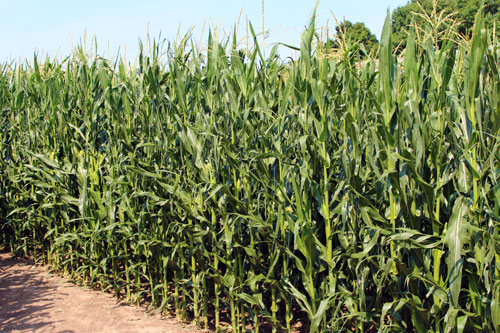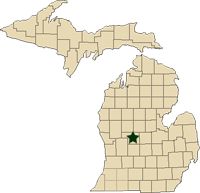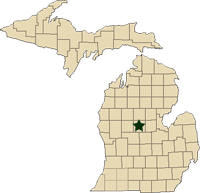Regional reports on Michigan field crops – July 12, 2012
MSU Extension educators’ pest and field crop updates for Michigan.
This week’s regional reports:
- West Central Michigan – Fred Springborn
- Central Michigan – Paul Gross
West Central Michigan – Fred Springborn, Michigan State University Extension
|
Weather
Scattered thunder showers over the week of the Fourth of July did bring some relief to dry crops in several parts of the region. Reports of 0.75 to 1.5 inches are fairly common for the week, particularly in the northern portions of the region. Not everyone received rain, however, with some areas on the southern edge receiving less than 1/10 of an inch. Wind damage is evident through the entire region from the storms regardless of rainfall amount. Some areas also received hail damage from these storms. High air temperatures ranged from the upper 80s to over 100 F over the two-week period. Low air temperatures were in the upper 50s to mid-70s. Soil conditions, especially subsoils, remain quite dry in many areas.

Minor hail damage did occur to many crops last week, including this corn
near Edmore, MI.
Crops
Wheat harvest is wrapping up. Yields have been variable with a wide range of yield reported from very good to moderately disappointing, even under irrigation. The water use by wheat was quite high during much of the spring, with the higher than normal temperatures and lower humidity levels keeping evapotranspiration rates high. Grain quality has been very good.
Oats are turning and a few fields have been harvested.
Corn ranges from V10 to tassel emergence. The overall condition of the crop is fair where irrigation is not available. The most severely stressed corn is in the south with corn in the northern areas just beginning to roll its leaves again mid-day. Irrigated corn is in very good condition. Continue to monitor soil moisture carefully in irrigated fields over the next few weeks.
Most alfalfa producers are harvesting or finishing up second cutting. Yields generally have been less than hoped for; in many cases, yield has been between 60 and 80 percent of normal for both cuttings, in some instances far less. Potato leafhopper numbers are increasing and will need to be monitored.
Dry beans are growing rapidly where adequate moisture is available. There are a few fields with minor root rot issues.
Soybeans are blossoming in many fields and are variable in height and number of nodes. Very low numbers of aphids are present and spider mites can be found.
The catch of western bean cutworm adults in pheromone traps is increasing with an average of 38 per night caught in the last five nights near Stanton, Mich.
Corn ear worm adults are also being caught, though the numbers are low at two to four per week in the last two weeks
Japanese beetle adults are present in corn and beans as well as other crops. So far the numbers are not threatening, but it is another insect very noticeable and worth monitoring.
Central Michigan – Paul Gross, Michigan State University Extension
|
Weather
The central region of the state has won the rain lottery during the Fourth of July holiday. Most of the region received at least 1 half inch of rain while some areas received about 3 inches. While this rain brought some relief, conditions are still very dry. Subsoil and topsoil moisture is running out and rain will be needed to avoid additional yield loss. The cooler temperatures have provided some relief as we enter into corn pollination this week.
Commodity reports
The corn crop is holding on with just enough moisture to keep things going. The early corn is tasseled and will be pollinating this week. There is still variability in stands. Corn on coarse-textured soils is drought-stressed and there will be some yield loss. Western bean cutworm moths are being caught in higher numbers. Peak flight is expected in the next several days. Scout fields for this pest and corn rootworm adults.
The soybean crop is holding its own just in time for the rains. The early planted fields are flowering. Scout fields for spider mites as pests have been found in several fields along the edges. Very few soybean aphids have been found.
Wheat harvest will wrap up this week. Yields varied widely across the region. There are reports of fields yielding over 100 bushels per acre. Most yields will be in the 65 to 85 bushel range. Everyone is reporting excellent quality. It appears that there may have been more damage from the early frost than anticipated.
Alfalfa harvest is progressing. Most of the second cutting is complete. Regrowth of the third cutting is 6 to 8 inches. Some later cut fields have been hurt by the dry conditions and yields will be small. The alfalfa this year has been hit early with frost and now drought. This will stress these plants. Consider fertilizer applications this summer to aid this crop going into winter. Potato leafhopper populations are high.
Oats are turning and harvest is expected to begin next week.
Dry beans are doing OK, but are in need of rain. There are some reports of root rots in some fields. Monitor western bean cutworm traps in your area and scout for this pest.
Sugarbeets are progressing. They are deep rooted and can hold their own until we get rain. Some root rots have been reported.



 Print
Print Email
Email



